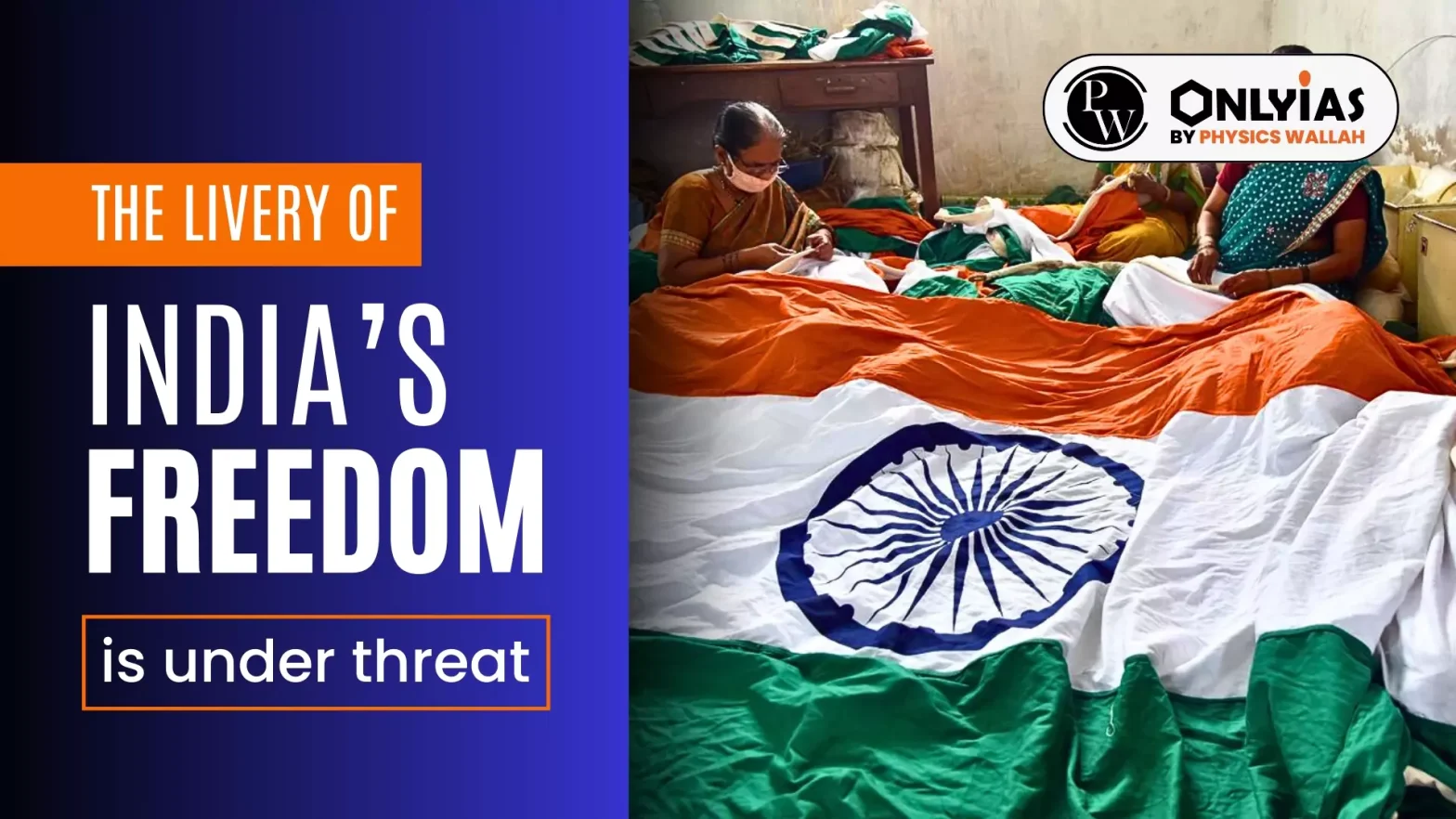In 2022, on the auspicious occasion of the 75th anniversary of our Independence, the Government amended the Flag Code to include “machine-made polyester bunting” and simultaneously exempted polyester flags from the Goods and Services Tax (GST).
This move put polyester flags on the same tax footing as khadi flags. The Prime Minister’s renewed call for the ‘Har Ghar Tiranga’ campaign in the week leading up to Independence Day (August 9-15) offers us an opportunity to reflect on the significance of our national flag and implications of above amendments for the khadi industry.
The Historical Significance of Khadi
- The Flag Code of India has traditionally required the national flag to be made of “hand-spun and hand-woven wool/cotton/silk khadi bunting.”
- Khadi, the coarse but versatile fabric that Mahatma Gandhi spun and wove during the national movement, holds deep historical and cultural significance.
- Khadi is at once a symbol of our storied past, and an icon of Indian modernity and economic vitality.
- It was an instrument to locate sovereignty and self-sufficiency during colonial rule and has continued to represent national integration and revitalization in independent India.
- It was in deference to this eternal symbolism that the tricolour once bore the Mahatma’s charkha as its centrepiece, and that the modern-day Indian flag used to insist on khadi as its sole fabric.
Enroll now for UPSC Online Course
The Government’s Decision and Its Impact
- In 2022, the Government’s decision to include machine-made polyester bunting in the Flag Code and exempt it from GST, while placing it on the same tax footing as khadi flags, was a significant shift.
- The Karnataka Khadi Gramodyoga Samyukta Sangha (KKGSS), the only national flag manufacturing unit accredited by the Bureau of Indian Standards (BIS), went on an indefinite strike to protest against what they viewed as a state-sponsored attack on India’s khadi industry.
- This policy change came at a time when India, no longer a global hub for polyester manufacturing, became a net importer of polyester yarn, primarily from China. This shift tends to undermine our national pride, especially amid tensions with China and the Prime Minister’s ‘Aatmanirbhar Bharat’ initiative.
- This shift would also have direct and calamitous consequences for the Mahatma’s foremost legatees — our khadi spinners and weavers.
The Broader Consequences for the Handloom Industry
- Demonetization, punitive GST policies, and the unplanned COVID-19 lockdown have forced many handloom workers to quit their professions.
- The Government’s neglect has unravelled our handloom traditions, which are a testament to our shared history and culture.
GST Burden on Handloom Workers
- The GST burden on handloom workers is significant, with taxes applied to both the final product and raw materials such as yarns, dyes, and chemicals.
- Despite consistent demands from workers to exempt handlooms from GST, their pleas have been ignored.
- Rising costs, particularly for electricity and cotton fibre, further strain the industry.
- The Vishwakarma Yojana, launched to support artisans, does not include handloom spinners and weavers, reflecting a gap in support for these crucial workers.
Check Out UPSC CSE Books From PW Store
Falling Khadi Procurement and Global Relevance
- Government procurement of khadi has declined as departments ignore or override mandates for its purchase.
- There has been less effort to build a global market for Indian handlooms, even as global consumers increasingly value sustainable and fair-trade products.
- Failure to regulate the market has led to confusion between semi-mechanized khadi and traditional hand-spun khadi, impacting the livelihoods of our khadi spinners, who earn inadequate wages despite their hard labour.
The Path Forward: Restoring Khadi’s Prestige
The path forward requires reimagining the role of India’s handloom traditions in our society and economy.
- Export Promotion: Strengthen global marketing and promotion of Indian handlooms to expand their international presence.
- Flag Code Amendment: Revoke the recent amendment to the Flag Code that allows polyester bunting and return to the use of traditional materials like khadi.
- Reviving the Khadi and Handloom Industry: Implement measures to support and revitalise the khadi and handloom sectors, ensuring their growth and sustainability.
Enroll now for UPSC Online Classes
Conclusion
Thus, khadi as the exclusive fabric for our national flag should be restored . This fabric, described by Pandit Jawaharlal Nehru as “the livery of India’s freedom,” must be reinstated as a symbol of our national pride. Also, the preservation of the handloom industry is crucial not only for economic reasons but also for maintaining our cultural heritage. India’s diverse handloom traditions, such as Chanderi, Muga silk, and Pochampally, are integral to our legacy. To safeguard this sector, it is essential for the government to support MSMEs and exempt GST on handloom products.
![]() 20 Aug 2024
20 Aug 2024

